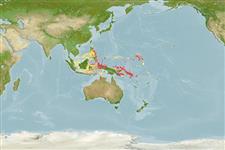>
Acanthuriformes (Surgeonfishes) >
Pomacanthidae (Angelfishes)
Etymology: Chaetodontoplus: Greek, chaite = hair + Greek, odous = teeth + Greek, plous, ous, oo = crossing (Ref. 45335); poliourus: Named for its grey caudal fin..
More on authors: Randall & Rocha.
Environment: milieu / climate zone / depth range / distribution range
البيئة
بحري مرتبطة بالشعاب; نطاق العمق 1 - 20 m (Ref. 90102). Tropical
التوزيع
دول | مناطق الفاو | النظام البيئي | الظهور | Point map | مقدمة | Faunafri
Western Pacific: Papua New Guinea, Solomon Islands, Palau and Indonesia.
الحجم / وزن / العمر
Maturity: Lm ? range ? - ? cm
Max length : 8.6 cm SL ذكر/ مختلط الجنس; (Ref. )
وصف مختصر
الوصف الخارجي | قياسات المظهر الخارجي
الأشواك الظهرية (المجموع): 12; الأشعة الظهرية الناعمة (المجموع): 17; شوكة شرجية 3; أشعه شرجية لينه: 16 - 17; فقرات: 24. This species is distinguished by the following characters: D XII,17 (rarely 16or 18); A III,16 or 17; pectoral rays 15-17 (usually 16); small scales, about 80 in longitudinal series; dorsal series of pored lateral line scales 29-35; gill rakers 4 + 12; supraneural bones 2; body depth 1.70-1.85 in SL; head length 3.15-3.3 in SL; fourth to sixth dorsal spines longest, 1.1-1.3 in HL. Preserved color head and anterior body pale yellowish grey to an approximate oblique demarcation connecting base of second to third dorsal spine to anus, gradually changing posteriorly in an intermediate zone containing pectoral fin to one of irregular longitudinal lines on dark brown; a dark brown bar from nape, broadening as it passes through eye, then curving and narrowing as it ends shortly before origin of pelvic fins; front of lips brown; dorsal and anal fins colored as adjacent body; caudal fin abruptly pale grey; paired fins pale yellowish. Color in life: dark brown posteriorly with white dots, which merge anteriorly to form narrow irregular white lines; dark brown of body progressively lighter anteriorly, becoming pale grey at demarcation, then gradually changing to pale yellow on head; ocular bar black, narrowly edged in bluish white; snout and chest yellow, the front lips blue which sometimes continue as a narrow triangle medially in front of snout; first 3-4 dorsal spines and membranes yellow, the rest of fin dark brown with rows of white dots paralleling rays on about basal 3/4 of fin; narrow white or blue margin on soft part of fin; anal fin similar, but not yellow anteriorly; caudal fin grey with a narrow yellow posterior border; pectoral fins pale grey; pelvic fins bright yellow (Ref. 82330).
Very close to Chaetodontoplus mesoleucus (Bloch, 1787) with different colors on pelvic, dorsal and caudal fins. The two species coexist in several islands of Indonesia (Ref. 82330). These islands include Lesser Sunda Islands. Molucca Islands, Halmahera, and Bird's Nest Peninsula of West Papua (Ref. 90102).
Life cycle and mating behavior
النضج | التكاثر | وضع البيض | بيض | الخصوبة | Larvae
Randall, J.E. and L.A. Rocha, 2009. Chaetodontoplus poliourus, a new angelfish (Perciformes: Pomacanthidae) from the Tropical Western Pacific. The Raffles Bull. Zool. 57(2):511-520. (Ref. 82330)
IUCN Red List Status (Ref. 130435)
استخدامات بشرية
مزيد من المعلومات
دولمناطق الفاوالنظام البيئيالظهورمقدمةStocksالبيئةالتغذيةعناصر الغذاءاستهلاك الأغذيةRation
الأسماء الشائعةمرادفاتالأيضمفتريساتعلم السميات البيئيةالتكاثرالنضجوضع البيضتجمعات وضع البيضالخصوبةبيضتطور البيضة
العمر/ الحجمنموالطول-الوزنالطول-الطولالطول- التردداتقياسات المظهر الخارجيالوصف الخارجيLarvaeحركة انتقال اليرقاتتوظيفالوفرةBRUVS
مراجعالأستزراع المائيملف الأستزراع المائيسلالاتجينيElectrophoresesالتوريثالأمراضمعالجةNutrientsMass conversion
المتعاونينصورStamps, Coins Misc.اصواتالتسمم باكل السمكسرعةنوع السباحةمنطقة الخياشيمعظمة الأذندماغرؤية
أدوات
تقارير خاصة
Download XML
مصادر علي الأنترنت
Estimates based on models
Preferred temperature (Ref.
123201): 28.8 - 29.3, mean 29 °C (based on 385 cells).
Phylogenetic diversity index (Ref.
82804): PD
50 = 0.5000 [Uniqueness, from 0.5 = low to 2.0 = high].
Bayesian length-weight: a=0.03090 (0.01359 - 0.07026), b=2.89 (2.70 - 3.08), in cm total length, based on LWR estimates for this (Sub)family-body shape (Ref.
93245).
Fishing Vulnerability (Ref.
59153): Low vulnerability (10 of 100).
